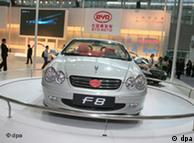经济纵横 | 2009.11.16
电动汽车离市场已不远 离中国市场更近
弗拉尔贝格州希望能成为奥地利的先行者--并且不想等到大汽车厂商终于将大量成熟的电动车投放到市场上的时候,一家地区能源供应商的董事会 成员哲尔曼自己开始寻找,并且在挪威找到了答案,"唯一的提供者是挪威的思考(Think)公司,我们提早与他们取得了联系。市场早已经有了,我们现在接 到了很多的客户咨询,通过这家挪威公司我们能够满足这些要求。"
思考公司生产的35辆微型车被奥地利人从挪威运了过来。到今年年底会达到100辆。这是能源公司新想法的最好例子:从单纯的能源公司变成汽车行业的领导者。在弗拉尔贝格,客户月付551欧元就得到一辆电动车,可以在停车场通过接口充电,还有相应的保险和公共交通卡。
德 国"欧洲太阳能"公司的安杰尔认为,奥地利人选择了正确的道路,安杰尔是太阳能汽车方面的专家。他说,电动汽车是一个未来价值几十亿欧元的市场,最终会受 到严肃的对待-即使电动车早已不是什么新鲜事物。如果不是燃油发动机的开发者们从中作梗的话,早在100年前电动汽车就应该不断涌现了,"非常古老的一些 汽车生产商,比亨利福特还要早一些,都是当时的激进分子。这些当时的激进分子放在今天就是主流,而今天的主流放在过去就是激进分子,历史就是这样的不断重 复。"
汽车行业意识到,汽油和柴油发动机不再是能不断赚钱的东西了,总有一天原油储备会被消耗光。安杰尔说,实现经济增长的唯一解决方案就是生产电动汽 车。长期以来都没有搞清楚,怎样才能产生对电动汽车市场的推动力,这是最关键的。他表示,省钱将成为决定性的因素,"如果购买电动汽车能够帮助人们将钱省 下来,留在自己的钱包里,那么电动汽车的时代就来了。"
在格拉兹的汽车配件供应商马格纳·斯泰尔,将从2012年开始大量提供电动汽车。到2020年时,应该有110万辆这样的车在路上行驶。由于对一家 公司来说,研究经费过高,因此许多大的生产商合作发展电动汽车平台。在研究的过程中主要问题是锂离子电池的效率、寿命和重量。光是装在汽车上的电池就重达 250公斤,一次充电能跑100-150公里。一辆车每100公里消耗20到25千瓦的能量。马格纳·斯泰尔公司的派尔说,制造电池组的原材料稀有金属 锂,还够开采150年。现在西方必须保障来源,否则中国就会捷足先登,"一方面,中国自己拥有大量对电动发动机非常重要的稀有金属矿藏,另一方面他们在政 治上积极行动,在原材料交易市场上很活跃。他们已经与锂储量丰富的南美国家签约,让这些材料能够确保中国在能源研究上的领先,比如说中国也在进行的电动汽 车计划。"
2006年,中国已经有2000万电动摩托车,比用内燃机的还多。但是这增加了电网的负担,如果他们全都同时充电会怎么样?需要多久,在哪里充电,还有充电时间须要多长?充的电要如何收费,谁来推动电力终端设备的发展?
这些问题还没有清晰的答案。但肯定的是:电动汽车的能源消耗带给能源厂商的收入并不多。比如在奥地利:如果有100万电力车上路,能源消耗只会上升3%。为此能源集团参与更多的生意,经营充电站和租赁业务。就像示范地区弗拉尔贝格那里一样。
美 国加利福尼亚的佳地公司(Better place)走了另外一条路,负责欧洲市场的余丹说,电池经过长距离行驶之会变弱,人们可以去一家专门更换电池的地方,"在那里人们可以用用光了的电池换 另一块满的电池。第一个项目我们建立在以色列和丹麦,在法兰克福的国际汽车展览会上,我们与雷诺签订了一份合同:雷诺生产的10万辆电动车将销往以色列和 丹麦,从2011年开始。这已经是一个很大的量,这不是实验项目,而是真正批量生产的电动汽车。"
作者:Alexander Musik/子江
责编:谢菲
EDITORIAL: China's auto industry
2009/11/18
From January through October, China's automobile output and sales both exceeded 10 million units. The figures could each top 13 million by the end of this year, which would make China the world's top vehicle maker as well as largest sales market for the first time. Currently, the United States leads the world in sales, and Japan in production.
New vehicle sales in China grew sixfold in the last decade. In sharp contrast, the U.S. market shrank rapidly after the global economic meltdown forced General Motors Corp. and Chrysler LLC to file for bankruptcy. Japanese automakers, which had depended on the U.S. market for growth, also slumped.
China is expected to overtake Japan in terms of gross domestic product next year at the earliest--an achievement befitting a nation that is now seen as a new engine to drive global economic growth. But given the grave impact of a bloating Chinese auto market on energy resources and the environment, the situation signals the urgency of technological renovation to shift to non-gasoline cars.
China's Communist Party and government have actively promoted the auto industry for its huge potential to create jobs and push technological development in a broad range of sectors. Expressways built in China over the last decade are more than six times longer than the total in Japan.
When China's annual vehicle production reached the 10-million mark for the first time last month, the occasion was celebrated with a new model of the Jiefang (Liberation) truck rolling off the assembly line at state-owned China FAW Group Corp.
Passenger cars became the market mainstay a few years ago. Rising income levels in China have made them affordable to more citizens. With the emergence of domestic automakers, inexpensive passenger cars have become available. The government has been promoting sales with tax breaks and subsidies for buyers.
In 2008, China's per-capita GDP topped $3,000 (about 267,000 yen)--the watershed that turns a nation into a mass consumer society. Japan got there in the early 1970s.
With car ownership still less than 5 percent today, China is on the threshold of motorization.
According to International Monetary Fund projections, China will have roughly doubled its per-capita GDP by around 2015. New vehicle sales at that time are expected to increase to 15 million units, comparable with sales in the reviving U.S. market. The figure in China is estimated to reach about 20 million around 2020.
That's effectively double the scale of today's Chinese market. And if 20th-century-type gasoline cars are still the mainstay, the massive energy consumption and environmental destruction that will result are too horrendous to even consider.
Beijing is aware of the need to save energy and protect the environment if the nation's auto industry is to keep growing. The Chinese government has taken measures, including more stringent fuel-efficiency requirements, tax breaks for small cars and support for the development of electric vehicles and other green cars. It has also begun improving rail, subway and other mass public transport services. These efforts must be enhanced.
The Chinese auto market has become a battleground where Japanese, U.S., European, South Korean--and now Chinese--automakers are engaged in cutthroat competition.
To survive in this burgeoning market, we hope Japanese makers, which have been leading the world in gas-electric hybrid and other clean-car technologies, will remain leaders in the "green revolution" by using their technological expertise to offer affordable green cars and help the auto industry grow without sacrificing the environment.
--The Asahi Shimbun, Nov. 17(IHT/Asahi: November 18,2009)

沒有留言:
張貼留言